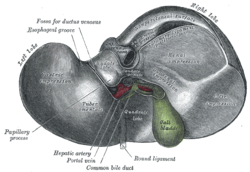Cholecystectomy
Cholecystectomy is surgical removal of the gallbladder.[1]
Indications[edit | edit source]
- symptomatic gallstone disease (cholecystolithiasis);
- gallbladder cancer;
- biliary tract cancer.[1]
Patients with gallstone disease should have the cholecystectomy within their first hospitalization. It means, that the patient with biliary colic should undergo this surgery as soon as possible (after treatment of acute stage of his disease). Delayed surgery brings risk of another biliary colic before planned cholecystectomy.
Contraindications[edit | edit source]
Absolute contraindications are:
- generalised abdominal infection;
- late stage of pregnancy;
- serious bleeding disorders.
Relative contraindications are acute cholecystitis, obstructive jaundice, peritoneal adhesions or intraabdominal tumors.[2]
Preparation of the patient[edit | edit source]
Before cholecystectomy every patient should undergo:
- abdominal sonography (USG);
- MRCP (is prefered more than ERCP);
- CT (in case staging of malignant disease);
- and common internal examination.
Every patient undergoing laparoscopic cholecystectomy should be prepared for conversion (open surgery).[2]
Methods of cholecystectomy[edit | edit source]
Laparoscopic cholecystectomy is definitely preferred more than open surgery. Laparoscopic surgery is less invasive. It is connected with better and schorter patients recovery, shorter hospitalization and sooner patients return to work and their daily activities.[2]
Laparoscopic cholecystectomy[edit | edit source]
The first port is introduced in subumbilical area. Then is created kapnoperitoneum with maximal intraperitoneal preassure 12 mmHg. Into subumbilical port is introduced optical instrument and the surgeon can check peritoneal cavity. After that 3 other ports can be introduced for laparoscopic instruments (trocars). There are two ways of gallbladder structures preparation:
- anterograde preparation – the preparation starts on gallbladders body (removal of peritoneum) and continues to cystic duct and cystic artery, which are clipped and divided;
- retrograde preparation – it starts by preparation of cystic duct and cystic artery, their clipping and devising and then the surgeon continuous in preparation of gallbladder.[1]
All the important structures in this area (cystic duct, cystic artery, hepatic artery, common hepatic duct , left and right hepatic duct and portal vein) are covered by peritoneum.[1]
After the preparation of gallblader is finished, it is evacuated from peritoneal cavity via the subumbilical port.[2] Then a drain is introduced.
Complications[edit | edit source]
The most serious complications are:
- injuries to biliary system (ducts) – 0,3–0,5% of all cholecystectomies[2], there is a danger of biliary leakage and peritonitis, biliary obstruction;
- bleeding (hepatic artery or portal vein injury);
- peroperative injury of gallbladder with biliary leakage;
- pneumothorax;
- subcutaneous emphysema;
- herniation in scar. [2]
Conversion[edit | edit source]
Conversion means change of operative technique during operation. In this case it is change during laparoscopic cholecystectomy to open cholecystectomy. It happens in 1–5% of planned laparoscopic cholecystectomies[2]. The reasons are:
- peroperative complications (massive bleeding or biliary system injury which can not be fixed by laparoscopic technique);
- peroperative finding of serious peritoneal adhesions (caused by peritonitis or previous abdominal surgery);
- peroperative finding of serious liver cirrhosis and suspected portal hypertension (it means high risk of bleeding during operation).
Open cholecystectomy[edit | edit source]
Open cholecystectomy is indicated in patients with serious galbladder, biliary tract or liver pathology (especially tumors). There is several options for incisions:
- oblique subcostal incision (Kochers incision) – is usually preferred;
- upper midline incision;
- paramedian incision.[1]
The operative steps (anterograde or retrograde preparation[1]) and complications are the same as in laparoscopic cholecystectomy.[2]
New methods[edit | edit source]
- SILS – operative methods using one multiport serving for optical instrument and several laparoscopical instruments;
- NOTES (New Open Trends in Miniinvasive Surgery) – operative methode using preformed holes of human body, in case of cholecystectomy it means transvaginal or transgastrical performed miniinvasive operation.
Links[edit | edit source]
Related articles[edit | edit source]
Source[edit | edit source]
- www.wikiskripta.eu. Cholecystektomie [online]. ©2011. The last revision 2011-10-15, [cit. 2011-10-15]. <http://www.wikiskripta.eu/index.php/Cholecystektomie>.
References[edit | edit source]
- ↑ a b c d e f ZEMAN, Miroslav, et al. Speciální chirurgie. 2. edition. Prague : Galén, 2006. 576 pp. pp. 262-265. ISBN 80-7262-260-9.
- ↑ a b c d e f g h BURKITT, H. George – QUICK, Clive R. G. Essential surgery : problems, diagnosis and management. 4. edition. Edinburgh ; New York : Churchill Livingstone, 2007. 793 pp. pp. 326-328. ISBN 9780443103469.





